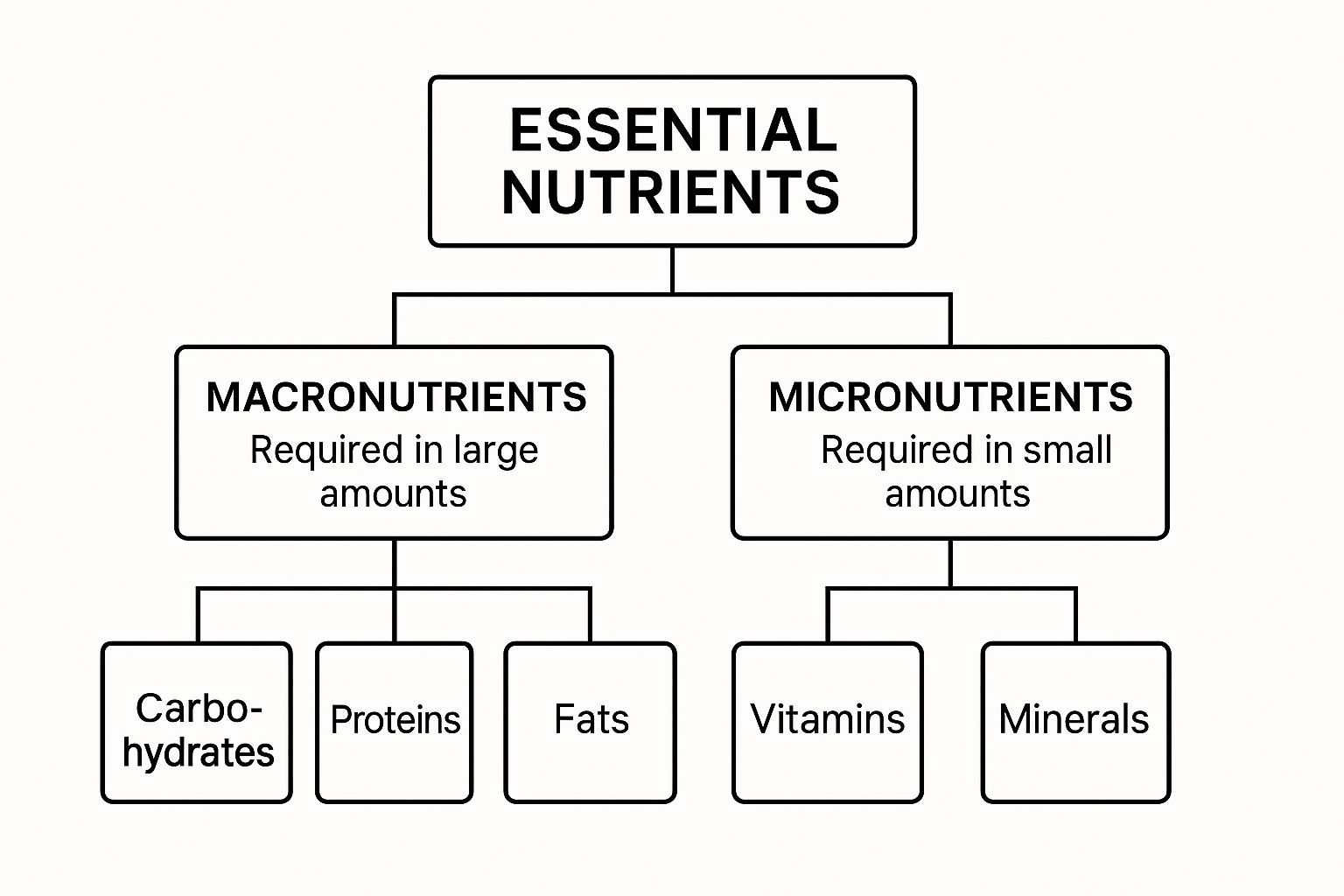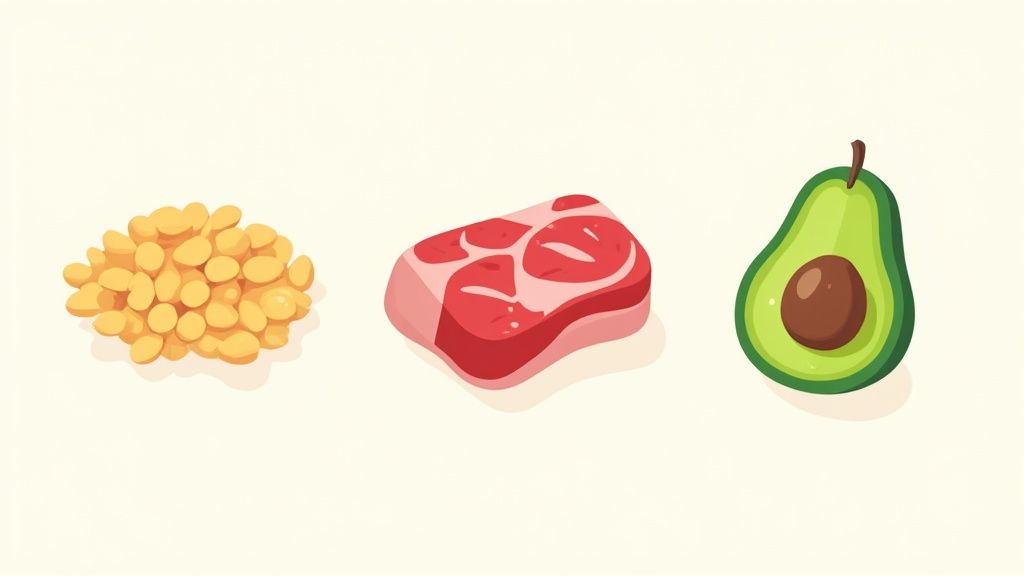What Are Macronutrients and Micronutrients? Your Essential Guide

Here’s the simple truth: Macronutrients are the nutrients your body needs in large amounts for energy and structure. On the flip side, micronutrients are those it needs in small amounts to keep everything running correctly.
Think of it like building a house. Macronutrients are the bricks, lumber, and concrete—the core materials you need tons of to build the structure. Micronutrients are the nails, screws, and wiring—you don't need nearly as much, but without them, the whole house would fall apart.
Building Your Nutritional Foundation
Getting a handle on macros and micros is the first real step toward taking control of your health, especially if you're trying to move away from a diet filled with sugar and other empty calories. These two groups cover all the essential nutrients you get from food, and each one plays a unique, vital role in keeping you going.
This diagram gives a great visual breakdown of how these nutrients are categorized.

As you can see, the chart neatly separates nutrients into the "macro" and "micro" camps, making it easy to understand the fundamental difference in the amounts our bodies need.
Macronutrients: The Major Players
Macronutrients are the heavy lifters in your diet. They provide the calories—the actual energy—your body needs to move, think, and just live. They're the foundation of every meal and fall into three main categories:
- Carbohydrates: Your body's go-to, most easily accessible source of fuel.
- Proteins: The essential building blocks for everything from muscle repair and tissue growth to a strong immune system.
- Fats: A dense energy source that's also crucial for producing hormones and absorbing certain vitamins.
If you don't get enough of these, you’ll quickly feel drained, weak, and completely out of steam.
Micronutrients: The Unsung Heroes
In contrast, micronutrients are the behind-the-scenes support crew. Your body only needs them in tiny, or "micro," amounts, but don't let the small quantities fool you. They are absolutely essential for your health.
Micronutrients act like spark plugs, igniting all the biochemical reactions in your body. They help you unlock the energy from your macros and make sure every system—from your brain to your bones—is working as it should.
These crucial helpers are divided into two groups: vitamins (like Vitamin C and the B vitamins) and minerals (like iron and magnesium). Each one has a specific job, contributing to things like bone density, immune defense, and converting food into usable energy. This is exactly why a varied, whole-foods diet is so important—it’s the only way to ensure you’re getting the full spectrum of both the "macro" fuel and the "micro" support team.
To make this even clearer, here's a quick side-by-side comparison.
Macronutrients vs Micronutrients at a Glance
| Nutrient Type | What They Are | Primary Role in the Body | Common Food Sources |
|---|---|---|---|
| Macronutrients | Nutrients needed in large amounts (grams). The "Big 3" are proteins, fats, and carbohydrates. | Provide energy (calories) and serve as the building blocks for growth and repair. | Meat, fish, grains, legumes, nuts, seeds, oils. |
| Micronutrients | Nutrients needed in small amounts (milligrams or micrograms). These are vitamins and minerals. | Support metabolic processes, immune function, and cellular health. They don't provide energy. | Fruits, vegetables, dairy products, fortified foods. |
This table neatly sums up the core differences, showing how both types of nutrients are indispensable partners in your overall health.
Understanding Your Body's Fuel Source

Alright, let's get into the nitty-gritty of what actually powers your body. We're talking about macronutrients.
Think of your body as a high-performance engine. To run smoothly, it needs the right kind of fuel. The three main types of fuel are carbohydrates, proteins, and fats. Each one has a specific job, and getting the balance right is the secret to feeling fantastic.
These are the nutrients your body needs in large amounts every single day to function. On a global scale, carbohydrates are king. One major study revealed that in 2013, the average person consumed about 2710 kcal/day. The breakdown was pretty clear: 70.5% of that energy came from carbs, 17.4% from fats, and 10.5% from protein.
Carbohydrates: The Fast-Acting Energy
First up, carbohydrates—or "carbs." These are your body's go-to, quick-access energy source. When you eat foods like fruits, vegetables, or bread, your body converts them into glucose (sugar), which is the primary fuel for your brain and the stuff that powers your muscles through a workout.
But here’s the crucial part: not all carbs are created equal. The source really, really matters.
- Simple Carbs: Think sugary drinks, candy, and white flour. They hit your system fast, giving you a quick sugar spike followed by an inevitable crash. You're left feeling drained and, ironically, craving more sugar.
- Complex Carbs: These are the good guys. Found in whole foods like oats, sweet potatoes, quinoa, and brown rice, they’re loaded with fiber. This means they digest slowly, giving you a steady, reliable stream of energy that lasts for hours. For more on keeping your energy up, check out our guide on how to increase energy levels naturally.
Proteins: The Master Repair Crew
If carbs are the immediate fuel, then protein is the dedicated construction and repair crew. Proteins are made of building blocks called amino acids, and your body uses them for just about everything.
They're essential for repairing muscle after a workout, building new cells, and keeping your skin and organs healthy. Protein is also vital for creating the enzymes and hormones that run the show behind the scenes. Simply put, getting enough protein is non-negotiable for a strong, resilient body.
Like carbs, the source matters. Complete proteins, which contain all the essential amino acids, are typically found in animal products like meat, fish, and dairy. Incomplete proteins from plant sources like beans and lentils are also fantastic—you just need to combine them to get the full set of amino acids.
Fats: The Long-Term Energy Bank
For years, fat got a bad rap, but the truth is, it's absolutely essential for your health. Fats are your body's long-term energy reserve, a dense fuel source it can tap into when the quicker energy from carbs runs out.
But fat does so much more than just provide energy.
- Hormone Production: Many of your key hormones, which control everything from your metabolism to your mood, are made from fat.
- Nutrient Absorption: Some vitamins (like A, D, E, and K) are "fat-soluble," meaning your body can't absorb them without fat present.
- Cellular Health: The protective membrane around every single cell in your body is made of fat. It's literally what holds you together.
The key, of course, is to choose the right kind. Focus on incorporating healthy fats from whole foods like avocados, nuts, seeds, and olive oil, and steer clear of the processed trans fats often lurking in packaged snacks.
Meet the Body's Unsung Heroes: Micronutrients

If macronutrients are the fuel that powers your engine, then micronutrients are the spark plugs, engine oil, and skilled mechanics that keep the whole system running smoothly. They are the vitamins and minerals your body needs, and while the amounts are tiny, their impact is anything but.
Think of them as the unsung heroes of your health. These tiny powerhouses are involved in thousands of critical processes every single second—from turning your last meal into usable energy to building strong bones and keeping your immune system on high alert. You really can't have one without the other; macros and micros are true partners in keeping you healthy.
But here’s a startling fact: getting enough of these essential nutrients is a huge challenge globally. A report from the Harvard T.H. Chan School of Public Health reveals that more than half of the world's population isn't getting enough key micronutrients like calcium, iron, and vitamins C and E. It’s a clear sign that we need to pay closer attention to the quality of our food, not just the quantity.
The Two Types of Vitamins
Vitamins are organic compounds that essentially act as project managers for your body, with each one overseeing different jobs. They fall into two main camps, and the difference comes down to how your body absorbs and stores them.
- Fat-Soluble Vitamins (A, D, E, and K): These guys need a little help from fat to get absorbed into your system. Think of dietary fat as their taxi service. Because they dissolve in fat, your body can store them in your liver and fatty tissues for later use. This means you don't necessarily have to get them in your diet every single day.
- Water-Soluble Vitamins (B-complex vitamins and Vitamin C): Just like their name suggests, these dissolve in water. This makes them easy to absorb, but it also means they don't stick around for long. Your body uses what it needs and gets rid of the rest, so you have to replenish your supply on a regular basis. They are absolutely vital for releasing energy from food and keeping your immune system humming.
Key Takeaway: Your body has a built-in savings account for fat-soluble vitamins but operates on a "use it or lose it" basis with water-soluble ones. Knowing this helps you understand why a consistent intake of certain foods is so important.
The Power of Essential Minerals
Now, let's talk about minerals. Unlike vitamins, which are made by plants and animals, minerals are inorganic elements that come straight from the earth. Plants absorb them from the soil, and we get them by eating those plants (or the animals that ate the plants). Minerals are the body's building blocks, providing structure to our bones and helping to maintain the delicate balance of fluids in our cells.
We can group minerals into two categories based on how much we need.
- Major Minerals: You need these in larger amounts. This group includes calcium for strong bones and teeth, potassium for proper nerve function, and magnesium, a workhorse involved in over 300 different bodily reactions.
- Trace Minerals: As the name implies, you only need these in very small quantities, but don't let that fool you—they're still absolutely essential. Iron, which is crucial for carrying oxygen in your blood, is a perfect example. Others include zinc for immune support and iodine for a healthy thyroid.
Even a tiny shortfall in a trace mineral can make a big difference in how you feel, affecting your energy and overall well-being. This is precisely why a diet rich in a variety of colorful, whole foods is your best bet for covering all your nutritional bases.
How to Build a Nutrient-Dense Plate
https://www.youtube.com/embed/roB5Yyh37Uk
Knowing the difference between macros and micros is a great first step, but the real magic happens when you put that knowledge on your plate. It's time to go from theory to practice and build meals that don't just fill you up but truly fuel you from the inside out.
The best part? You don't need a fancy calculator or a strict set of rules. One of the most effective and least stressful ways to get a solid mix of nutrients is a simple visual guide called the ‘balanced plate method’.
This approach is incredibly straightforward. It helps you build a powerhouse plate without getting bogged down in counting every last calorie or gram.
The Balanced Plate Method Explained
Think of your dinner plate as being split into three sections. Each part has a specific job, and they all work together to give your body the energy and the essential helpers it needs to thrive.
Here’s the breakdown:
- Fill Half Your Plate with Color: Start by loading up the largest part of your plate with non-starchy vegetables. We’re talking broccoli, spinach, bell peppers, zucchini, and all sorts of leafy greens. These foods are nutritional superstars—low in calories but bursting with fiber and a huge range of micronutrients. The more colors you can pile on, the wider the variety of vitamins and minerals you’ll get.
- Dedicate a Quarter to Lean Protein: The next section is for your protein source. This powerhouse macronutrient is essential for repairing tissues, maintaining muscle, and, importantly, keeping you feeling full and satisfied long after you've finished eating. Good choices include grilled chicken, fish, tofu, lentils, or beans.
- Complete the Plate with Complex Carbs: The last quarter of your plate is reserved for high-fiber, complex carbohydrates. These are your body's preferred source of slow-release energy, keeping your brain sharp and your body moving. Go for things like quinoa, brown rice, sweet potatoes, or whole-grain pasta.
Following this simple formula naturally creates a meal that balances your energy-giving macronutrients with a rich supply of vitamins and minerals. No overthinking required.
A Quick Guide to Key Micronutrients
To make smart choices when filling your plate, it helps to know where some of the most important micronutrients hang out. While getting comfortable with food packaging is a useful skill—and our guide on how to read nutrition labels can help with that—the best strategy is always to focus on whole foods first.
A nutrient-dense plate is your best defense against deficiencies and your ticket to sustained energy. By prioritizing whole foods, you ensure that every calorie you consume is working for your health, not against it.
This approach doesn't just benefit your physical health; it can also have a major impact on other parts of your life, like your sleep. For more on this connection, check out these tips on improving your diet for better rest.
To get you started, here is a quick-reference table highlighting some key micronutrients and where you can find them in everyday foods.
Key Micronutrients and Where to Find Them
| Micronutrient | Key Function | Top Food Sources |
|---|---|---|
| Vitamin C | Boosts immune system, promotes skin health. | Bell peppers, broccoli, strawberries, citrus fruits. |
| Iron | Carries oxygen in the blood, fights fatigue. | Spinach, lentils, red meat, pumpkin seeds. |
| Calcium | Builds and maintains strong bones and teeth. | Dairy products, leafy greens, fortified plant milks. |
| Magnesium | Supports muscle function and energy production. | Almonds, spinach, black beans, avocado. |
| Potassium | Regulates fluid balance and nerve signals. | Bananas, sweet potatoes, beans, yogurt. |
Use this table as a handy guide. You can start making small, intentional swaps today to boost the nutritional power of every single meal.
Why Nutrient Balance Is Your Secret Weapon for a Low-Sugar Lifestyle

Switching to a low-sugar lifestyle is about so much more than just ditching cookies and soda. It's really about upgrading the quality of everything you eat. This journey puts the relationship between macronutrients and micronutrients front and center, showing you just how crucial balance is for lasting success.
Think about processed, sugary foods for a second. They’re a classic example of what happens when nutrition goes wrong. They’re typically loaded with simple carbs (a macronutrient) but offer almost nothing in the way of essential vitamins and minerals (micronutrients). This is what people mean by "empty calories"—they give you a quick, fleeting energy spike but leave your body desperate for the actual building blocks it needs to run properly.
Ever wonder why you feel hungry again almost immediately after a sugary snack? It’s because your body never got the real nourishment it was asking for, which just ends up triggering another round of cravings.
Reframing How You Think About Food
When you start to consciously cut back on sugar, you automatically make room on your plate for foods that are packed with goodness. Instead of a donut for breakfast, you might reach for eggs (protein and fats) with a side of spinach (loaded with iron and vitamins A and K). That one simple trade does more than just cut out sugar; it showers your body with the high-quality macros and micros it's been craving.
This shift works wonders for stabilizing your blood sugar, which is the key to stopping those wild energy spikes and crashes that drive you back to the snack cabinet. Foods that release their energy slowly and steadily are the foundation of any sustainable, healthy diet. If you want to dive deeper into this, our guide on what is glycemic index explains exactly how this process works.
When you start focusing on what you add to your diet—fiber, protein, healthy fats, and a rainbow of vegetables—cutting out sugar stops feeling like a restriction. It becomes a strategy for getting the most nutritional bang for your buck out of every meal.
The Long-Term Wins of a Balanced Plate
Making nutrient density a priority over empty calories pays off in huge ways, well beyond just taming your sweet tooth. It’s a game plan for genuine, long-term wellness. A balanced mix of macronutrients and micronutrients is a team effort, supporting every single system in your body.
- Sustained Energy: With the right fuel from complex carbs, proteins, and fats, you can say goodbye to that dreaded afternoon slump.
- Fewer Cravings: When your body is truly nourished, your hunger signals become far more reliable and a lot less frantic.
- Better Overall Health: A steady supply of vitamins and minerals fortifies your immune system, bolsters bone health, and even brings a new level of mental clarity.
Ultimately, choosing to live with less sugar is about making every calorie count for something. It’s a powerful decision to fuel your body with purpose, giving it everything it needs not just to get by, but to truly thrive.
Let's Bust Some Common Nutrition Myths
Trying to figure out what to eat can feel like walking through a minefield. One minute, carbs are the villain; the next, fat is the ultimate bad guy. It’s time to clear the air and debunk some of the most stubborn myths out there so you can eat with confidence, not confusion.
Once you truly understand what macronutrients and micronutrients are, you'll have a powerful tool to cut through the noise. You’ll see that no single food group is inherently "good" or "bad"—it's all about context and quality.
Myth 1: All Carbs Are Bad for You
This is probably one of the biggest and most damaging myths in nutrition today. Let's get this straight: your body absolutely needs carbohydrates for energy. The real secret is knowing the difference between the types of carbs you're eating.
Sure, highly processed, simple carbs found in sugary sodas and white bread will send your blood sugar on a rollercoaster. But complex carbs from whole foods—think sweet potatoes, oats, and veggies—deliver a slow, steady stream of energy and essential fiber. Labeling all carbs as "bad" means you’d miss out on some of the most nutrient-packed foods on the planet.
Myth 2: To Be Healthy, You Must Avoid Fat
For years, we were told that low-fat diets were the holy grail of health. We now know that's just not true. Healthy fats are absolutely critical for everything from brain function and hormone production to absorbing key vitamins. The goal isn't to avoid fat altogether, but to choose the right kind.
- Healthy Fats: These are your friends. You'll find them in foods like avocados, nuts, seeds, and olive oil.
- Unhealthy Fats: Trans fats, which often lurk in processed and fried foods, are the ones you want to keep to a minimum.
Your body doesn't just want healthy fats; it needs them to thrive. Cutting them out completely does your health a major disservice, robbing your cells and hormones of the very building blocks they need to work properly.
Myth 3: A Multivitamin Can Fix a Bad Diet
It’s tempting to think a daily multivitamin can act as an insurance policy against poor food choices, but it just doesn't work that way. While a supplement can help fill in minor nutritional gaps, it’s not a magic bullet that can cancel out a diet high in processed foods.
Think of it like this: a supplement is meant to supplement an already healthy diet, not replace it. Real, lasting health is built one nutrient-dense meal at a time. Whole foods offer a complex mix of fiber, antioxidants, and other compounds that you simply can't bottle.
This isn't just an individual problem; it's a global one. Even with plenty of food available, huge nutritional gaps exist. Globally, over 5 billion people don't get enough critical micronutrients like iodine and calcium, and more than 4 billion are falling short on iron. This just goes to show how crucial it is to prioritize whole foods. If you're curious about this, you can dive deeper into these global nutrient challenges in this detailed analysis from TABLE Debates.